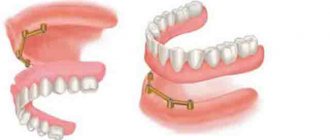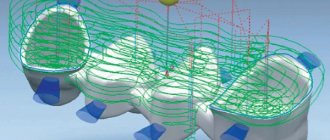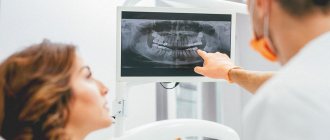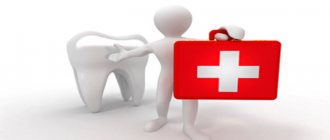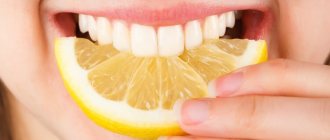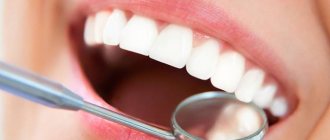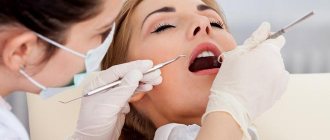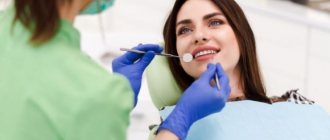Medicine is an area in which modern technologies have literally revolutionized in recent years. Dentistry, being one of the most knowledge-intensive areas of medicine, can serve as ideal proof of this. The changes that became possible thanks to the latest technologies have affected almost all its areas - diagnostics, treatment, prosthetics, prevention. New drugs and materials, research methods and computer modeling have become firmly established in dental practice. The most notable breakthroughs in this area include:
- the use of computer technologies in the process of diagnosis, treatment and dental prosthetics, digital radiology;
- use of laser in the treatment of oral diseases;
- the use of ozone to treat affected areas of the tooth;
- sanding with air;
- the use of new methods of pain relief in treatment and prosthetics;
- use of the latest materials for the manufacture of fillings, dentures and dental crowns.
It is worth talking about each of them in more detail.
Application of computer technology
Periodontitis diagnostic system “FLORIDA PROBE” (USA)
Today, diagnosis, treatment, and dental prosthetics are unthinkable without the use of one form or another of computer technology. Special computer programs are capable of simulating the patient’s oral cavity, which allows the doctor to more effectively make a diagnosis, select the type of therapy and prosthetics, and prescribe recommendations for the patient. And the patient gets the opportunity to visually familiarize himself with the condition of his teeth and better understand what their treatment and prosthetics will consist of.
Intraoral video camera
One of the most recent achievements is the so-called neuromuscular dentistry, which studies the neurophysiology of the oral cavity and the characteristics of the patient’s jaw movement and the activity of the masticatory muscles. It is quite obvious that obtaining and processing this kind of data is impossible without sophisticated computer technology. Also, in the country's leading clinics, programs are used that study the patient's facial expressions. Together, this allows the dentist to use a full animated model of the oral cavity, displayed on a computer display, where he can rotate the three-dimensional image in any direction and view it from different angles.
The intraoral camera is another new product that significantly facilitates the doctor’s work. The device is a microscopic video camera that is placed in the patient’s mouth and transmits an enlarged image to a computer screen. As a result, both the doctor and the patient have the opportunity to examine the condition of the teeth and gums in great detail. Sometimes, with the help of such a camera, a doctor can see details that even an x-ray cannot show him.
Fixed prosthetics
In case of complete destruction of one or more teeth, the orthopedic dentist selects a fixed prosthesis for the patient - a structure that replaces the missing units. Products differ in material of manufacture, cost, fixation technology, service life, ease of wearing and indications for installation. The most popular options in prosthetic dentistry are:
- Crowns.
- Bridges.
- Implants.
A crown is a kind of “cap” that is placed on the frame of a tooth or an implanted metal rod. The operation is carried out in several stages:
- Sanitation of the oral cavity - an orthopedic dentist treats foci of caries, inflammation of the gums, and, if necessary, carries out hygienic cleaning.
- Tooth preparation – part of the enamel and dentin is removed. If the tissue is severely damaged, the unit is removed and an implant is installed in its place - a metal rod implanted into the jaw bone.
- Making a crown from an impression. The orthopedic dentist creates a model of the prosthesis, which he sends to the dental laboratory. The technician makes the crown using the technology chosen by the client. The cost of the product, its aesthetics, and service life depend on this.
- Installation of the prosthesis. The crown is placed on a pre-ground base (or implant) and fixed with dental cement. At first, the patient may experience minor discomfort while the chewing apparatus adapts to the prosthesis. In the future, the crown is not felt and completely replaces the lost or damaged tooth.
Orthopedic dentistry is aimed not only at restoring the functionality of the dental system, but also at maintaining the beauty of the dentition. Therefore, crowns are not only reliable and durable, but also aesthetically pleasing. The appearance of the product depends on the selected material. An orthopedic dentist can offer the following types of prostheses:
- Metal.
- Metal-ceramic.
- Ceramic.
The most popular is metal ceramics. The crown has a metal frame onto which dental porcelain (or other ceramic composition) is applied in layers. As a result, the finished structure is durable and outwardly indistinguishable from a regular tooth. In addition, metal ceramics are more affordable than their counterparts made entirely of ceramics.
If not one, but several units are missing, bridge-like fixed prostheses are installed instead of crowns. They are several crowns combined into one design. The two outermost ones are fixed on previously prepared teeth, the rest fill in the missing units. The “bridge” has no visible metal fasteners, so it is invisible when eating or smiling. However, it has a drawback - wearing a bridge increases the load on the supporting teeth, so they are subject to accelerated wear. To avoid this, you can use implantation.
Implantation is another type of permanent prosthetics in orthopedic dentistry, which involves the implantation of a metal rod into the jaw bone, onto which a crown is subsequently placed. A good solution for filling both one and several missing teeth without increasing the load on neighboring units. But implantation is a complex procedure and can only be performed by an experienced orthopedic dentist. In addition, the cost of the operation is quite high and it cannot be performed on people with chronic diseases. In this case, removable dentures are used - metal or ceramic structures that imitate the tissues of teeth and gums. This is one of the most reliable and proven options that orthopedic dentistry can offer.
Laser Application
Nowadays, a very wide range of problems are solved with the help of lasers. Here are just some of the areas of its application:
- diagnosis and therapy for caries;
- treatment of periodontitis and pulpitis;
- removal of tumors of various nature;
- elimination of increased sensitivity of teeth;
- treatment of bleeding gums;
- acting as a scalpel during surgical procedures;
- complete disinfection of the oral cavity.
Laser therapy has a number of advantages over traditional methods of treatment:
- The laser provides 100% disinfection for all types of operations.
- There is no risk of bleeding when using it.
- All procedures are absolutely painless.
- Minimal traumatic effect on tissues, which contributes to their good regeneration.
This method has virtually no disadvantages. The only one of them can be considered its high cost today.
Modern orthopedic dentistry: tasks and goals
Dental tissue does not regenerate and in case of loss of dental units, a person is forced to resort to prosthetics. The main task of an orthopedic dentist is to offer the patient the most correct and advanced methods for restoring the dentition. The doctor also deals with:
- Treatment of injuries, acquired or congenital anomalies of the masticatory apparatus.
- Restoring the aesthetics and functionality of the dental system in case of complete or partial loss of teeth.
- Prevention of oral diseases such as periodontitis, periodontitis, pulpitis and others.
An orthopedic dentist will help correct your bite, cope with crowded teeth, and give the necessary recommendations for maintaining oral hygiene after implantation or in case of wearing orthopedic structures (braces, removable dentures). His tasks include not only restoring the functionality and beauty of the dentition, but also choosing a gentle treatment method - painless, safe, and not harmful to bone tissue.
For this purpose, orthopedic dentistry has an arsenal of modern techniques, among which are: microprosthetics, the creation of removable dentures, and the installation of fixed structures.
Use of ozone
Ozone is used mainly for caries. This is also a painless modern method that allows you to completely eliminate the use of a drill. The essence of the procedure is to completely disinfect the affected area of the tooth. After treating the tooth with ozone and destroying all pathogenic microorganisms, its surface is coated with an enamel-restoring composition. The entire disinfection procedure takes no more than half a minute. The advantages of this method:
- there is no need to use a drill to penetrate the affected area of the tooth;
- high speed of operation;
- complete disinfection;
- painless operation, which makes the use of ozone especially popular in pediatric dentistry.
The disadvantage is that its use is not always possible. There are deep dental lesions when it is impossible to get to the desired area without a drill.
When to contact an orthopedic dentist?
Orthopedic dentistry allows people to maintain the functionality and beauty of their teeth throughout their lives. This requires only regular visits to an orthopedic dentist. You should contact a specialist if:
- Formation of malocclusion in childhood or adolescence.
- Mechanical injury to the jaw.
- Enamel destruction for various reasons.
- The appearance of chips and cracks on the surface of teeth.
An orthopedic dentist will conduct the necessary tests, recommend ways to restore the integrity of the teeth, and help get rid of crowding or other developmental pathologies. However, the patient must understand that a one-time visit is not enough. Most procedures will require several visits to the clinic, but the result - a snow-white, even smile - will stay with you for life!
The main thing is to choose reliable specialists. Competent and experienced doctors work at the Ulybka dental clinic. You can find out prices for services provided in the field of orthopedic dentistry on our official website in the “Prices” section.
Air sanding
In modern dentistry, there are different ways to replace the drill when treating affected areas of the teeth before installing a filling. One of them is the use of air to grind the tooth surface (microabrasive processing). With air, microscopic abrasive particles are supplied to it, which grind the tooth, removing the affected parts of the tissue. The method is characterized by high precision directed air flow, which helps protect nearby tissues from damage. This method is recommended for use in the early stages of caries.
Modern implantation systems as a high-quality alternative to removable solutions
A lot has also changed in the field of dental implantology. If until recently the only available option was a two-stage technology, that is, when artificial roots were first installed and only after 3-6 months prosthetics were performed, today patients have new opportunities for comprehensive dental restoration - one-stage protocols. The essence of these techniques comes down to fixing a complete denture on 3, 4, 6 or more implants with immediate installation of the device on the same day or within a week. We are talking about such popular methods today as all-on-3 (Trefoil) for the lower jaw, all-on-4, all-on-6, Basal Complex for cases of more pronounced bone tissue atrophy against the background of inflammatory processes and with complete edentia .
These concepts involve inclined implantation of titanium roots on the sides, which increases the area of contact with bone tissue and improves primary stability. In cases of more acute atrophic processes, elongated models of implants can be used, including zygomatic ones, which reach a length of 6 cm and are attached to the zygomatic bone of the skull. Among the distinctive features of one-stage implantation, experts highlight the opportunity to avoid bone grafting and long waits before prosthetics. An important stage of treatment is preparation - each step is carefully worked out using advanced software and 3D visualization programs.
To position the implants as accurately as possible, the surgeon uses special surgical templates, which are also developed using innovative computer programs. These are small elastic pads with slots - they are fixed on the gums and allow you to place artificial roots in precisely specified places. These technologies are relatively new discoveries in dental prosthetics, and therefore not all dental clinics can still offer the possibility of restoring teeth using one-stage methods.
Modern methods of pain relief
Electronic automated anesthesia system “SLEEPER ONE” (France)
One of the greatest achievements in the field of dentistry has been the invention of new methods of pain relief. Anyone who has had problems with teeth knows that the main issue for the patient has always been the possibility of effective pain relief. For many, fear of painful procedures has become the main reason for refusing dental treatment, leading to disastrous results. Today, not only new treatment methods that do not require anesthesia at all, but also modern methods of pain relief help to overcome this problem.
Among the medications, it is worth noting the newest drugs that have replaced the usual novocaine and lidocaine. Their effect is many times stronger and does not give side effects. In addition to medications, other new means are now being used. One of them is sedation. This is a type of anesthesia in which the patient is not completely immersed in sleep with a complete loss of consciousness. The state of sedation can be called superficial sleep, when the patient is conscious, but with an altered pain threshold and reduced anxiety. The drugs necessary to achieve this state are introduced into the body in the form of a breathing mixture (breathing mask), or in the form of an intravenous infusion. The method has much fewer contraindications and side effects than general anesthesia.
Modern materials of a new generation
Dentistry is progressing at a rapid pace, and new, more advanced materials are appearing in the field of prosthetics. Below we will consider new products that have made it possible to significantly improve the quality of modern orthopedic structures and the degree of comfort during their use.
New generation acrylic
Improved acrylic with the addition of diamond chips is more durable. In addition, the material has significantly fewer pores, which prevents the accumulation of bacteria and plaque on it. The finished orthopedic device is polished with a diamond bur to achieve perfect smoothness and improve aesthetic properties. Among the main advantages of new generation acrylic, experts highlight the following points:
- resistance to increased loads,
- preservation of shape due to sufficient hardness of the material,
- high aesthetics due to the light pinkish tint and translucency of the material, which makes it suitable for the external characteristics of natural gums,
- the absence of strong pressure on the mucous membrane due to the lightness of the material, therefore adaptation models for immediate loading protocols are created from it,
- possibility of repair and correction of the product.
The designs are easy to manufacture and their creation does not require too much time. In addition, the affordable cost of such a solution becomes a significant advantage.
Ceramic composite for creating crowns and bridges
Ceramic composite products are distinguished by high strength and excellent aesthetic characteristics. The service life of products made from this material is at least 10 years. The material is stronger and cheaper than pure ceramics, but at the same time much better in terms of aesthetics compared to conventional composite.
One of the main advantages of the material is the ability to correct the crown using the direct method, that is, without resorting to replacing it. Such structures are lined with photopolymer or composite materials with the addition of ceramics, which become hard only under a UV lamp. Ceramic composite is one of the optimal solutions for creating single crowns, veneers, and bridges.
Trinia material for creating the base of an orthopedic device
We are talking about an innovative material patented by Bicon, also known for its implantation systems. The basis of a future prosthesis is created from a block reinforced with fiberglass. Such structures with a Trinia frame are fixed on implants. In this case, the material is used to create both single crowns and bridges, as well as conditionally removable and removable orthopedic structures. In terms of strength, the material surpasses even zirconium dioxide. Due to its characteristics, it has found wide application not only in medicine, but also in the aerospace industry.
Fiberglass structures are used as part of implantation using one-stage techniques. They are quite light, so they can be safely placed on implants already 3-5 days after implantation. In addition, the Trinia frame will not show through, which generally improves the aesthetic characteristics of the product.
Latest materials
ICON technology
Most of all, the latest materials are in demand, of course, in prosthetics. However, today they play a huge role in dental treatment (in particular, in fillings). Innovative composite materials are used when placing fillings. The use of many of them allows you to simultaneously replace drilling a tooth with a drill and fill voids in damaged tooth tissue. Often, the use of such techniques allows you to perform all the necessary manipulations for the treatment of caries in one visit.
A popular method of such treatment is Icon or liquid filling. Its essence lies in the fact that the light-composite material is applied to a specially prepared diseased tooth and penetrates into its structure. The procedure is repeated 2 times. Hardening of the substance that has impregnated the tooth tissue occurs under the influence of light. This way the affected area is sealed. At the end of the procedure, the tooth is polished, and the filling site becomes indistinguishable on its surface.
A similar technology is used when installing a photo seal. A composite material is also used here, which, under the influence of ultraviolet light, hardens inside the tooth and can take the desired shape. The method is also widely used to restore lost areas of teeth and chips on fillings, as it is durable and allows you to build up any desired volumes layer by layer.
Microprosthetics for a perfectly beautiful smile – veneers, lumineers and ultraneers
When discussing innovations in dentistry, one cannot ignore such a topic as microprosthetics. This term usually refers to restoring the shape and appearance of the crown using a direct or indirect method. In the first case, the doctor literally builds up the crown using composites directly in the patient’s mouth.
The indirect method usually involves the production of special thin overlays on the teeth - veneers, which are then attached to the front side and successfully hide small irregularities, chips, cracks, interdental spaces and yellowed enamel. Such thin plates are made from ceramic or zirconium. The disadvantages include the need to prepare live crowns and the rather high cost. However, today this is one of the few ways to achieve a perfect smile in the shortest possible time.
“I have been considering options for in-office whitening for a long time, and with the advent of veneers I began to carefully study this issue. Last year I finally decided to give myself a perfect smile. I chose karmic ones, on the advice of my dentist. So far nothing has come off, overall I’m very pleased with the result. I don’t know what other procedure can make teeth perfect so quickly.”
Tatyana V., Moscow, from correspondence on the woman.ru forum
PROSTHETIC PROSTHETICS WITH 4 STRAUMANN IMPLANTS “teeth in 1 day” - RUB 220,000. until January 15, 2022!
Complex implantation using ProArch technology (Switzerland) with immediate loading on the day of surgery!
Call now or request a call
An improved version of veneers are lumineers and ultraneers. These are even thinner ceramic plates that are fixed on the front teeth and do not require grinding. The cost of such microprosthetics will be even higher, but the result will justify the investment.
Prostheses made of zirconium dioxide, pressed ceramics, keromer
Today we are talking about the most modern types of dentures. And, of course, these include those made from highly durable, hypoallergenic, highly aesthetic and very wear-resistant materials.
Zirconium dioxide
Previously, patients had very limited choices. Thus, to restore chewing molars and premolars, many chose dental prosthetics options such as metal or metal-ceramic crowns.
Metal ceramics were in great demand, as they had an optimal balance in price, quality and aesthetics. However, it could provoke allergies and galvanic syndrome, as well as make the gum in the area of contact with the crown blue due to oxidative reactions occurring in the metal component. For the front teeth they used very beautiful, but rather fragile ceramics.
The photo shows a zirconium dioxide crown
But such a modern material as zirconium dioxide1 is universal. They can be used for prosthetics of both front and chewing teeth. It produces different types of metal-free prostheses: single crowns, extended bridges supported by natural teeth and implants. It does not cause allergies, does not oxidize, is highly durable, and does not change color throughout its entire service life (more than 15 years). The material is processed using modern computer technology and milling machines, so the end result is very precise designs that are as comfortable as possible and correspond to all the patient’s characteristics.
Pressed ceramics E.max and E-empress
These materials, unlike conventional ceramics, are pressed during the processing stage, and therefore are more durable and wear-resistant, resistant to staining from drinks and foods. What types of dental prosthetics can be created from pressed ceramics: crowns supported by natural teeth, small bridges (to replace a maximum of one lost unit), veneers, inlays.
To produce high-precision structures from these materials, as with zirconium dioxide, you need to use CAD/CAM technologies and computer software.
The photo shows CAD/CAM technology
Keromer or ceramic composite
The combination of ceramics and composite has become truly innovative. It can be used to create types of dental prostheses that are supported by implants. These can be single crowns or extended bridges to replace all teeth lost in the jaw.
The material combines lightness and strength, high aesthetics and wear resistance. For restorations on implants, permanent structures are made from ceromer with a service life of more than 15 years. Moreover, some implantation protocols (one-stage) allow them to be installed within 2-3 days after implantation. They do not overload the artificial roots, while in a short time they allow you to return to full chewing of food. This is an excellent solution for patients who want to shorten the stages of treatment and immediately begin to enjoy life to the fullest. That is, do not wear adaptation prostheses first and wait until the artificial roots take root.
Tooth regeneration
One of the most interesting and promising areas in dentistry is dental regeneration and caries prevention. Bioactive dentin replacement* allows dentists to completely rethink the way they treat teeth.
Regenerative medicine today relies heavily on research into the use of stem cells and, in particular, research is currently underway to find the source of mesenchymal stem cells that have the ability to form teeth.
In April of this year, scientists from Harvard and Nottingham Universities have already developed a dental filler that allows teeth to heal on their own. This substance works by using stem cells to stimulate dentin growth, allowing the patient to regrow diseased teeth. Imagine that you were able to get rid of your artificial teeth, which will replace your own in old age.
Computer aided design and 3D printing
Computer modeling and manufacturing technologies using 3D printing are beginning to revolutionize dental laboratories. They are being transformed into significantly cheaper and more efficient digital laboratories.
With the help of new technologies, the manufacturing process, for example, of crowns, is significantly accelerated. The tooth is prepared for installation of the prosthesis, then a picture of it is taken, which is sent to the computer, which controls the machine, which produces a crown suitable for this particular patient right in the office and very quickly.
By using 3D printing, all intermediate stages that create a queue are eliminated, and the doctor’s work is significantly simplified. Such solutions for dentists are already offered by Stratasys, Envisiontech and FormLabs.
A virtual reality
Just like augmented reality technology, virtual reality (VR) can be used for training and professional development of dentists. Today, only a couple of students can peek over the surgeon's shoulder as he performs a complex operation, and this significantly complicates the learning process. But a VR camera allows you to broadcast an operation around the world and do it literally “through the eyes of a surgeon” if students use VR glasses. For example, this summer, Nobel Biocare already organized a broadcast of a dental operation, which was available through virtual reality devices.
Virtual reality technology is also useful for patients - recent experiments have shown that VR broadcasts of natural, relaxing scenes work great as a pain reliever for people in the dentist's chair, while leaving a pleasant aftertaste.
Teledentistry
Many people find it difficult to visit the dentist due to distance, illness, disability or old age. Telemedicine in dentistry is designed to solve this problem by providing easier and cheaper access to treatment. At the same time, it is intended to shift the emphasis from advanced treatment to preventive procedures, allowing patients to consult with a specialist more often and take the necessary measures in a timely manner. In the United States, this service has already begun to spread widely. For example, MouthWatch launched a fully integrated turnkey telemedicine system for dentists called MouthWatch TeleDent. This system is a platform for dentists or hygienists to provide visual consultations to patients in remote locations and evaluate their oral health in real time (or at other times at the patient's request) using a regular web browser.
Prospects for modern orthopedics
As for opportunities and prospects, today dentistry offers many innovative solutions for various categories of patients with different financial capabilities. Let us remember that modern orthopedic devices are created using 3D modeling programs, and the CEREC system with CAD/CAM technology at its core allows you to create inlays, veneers and crowns in just one visit, that is, right in front of the patient.
On a note! Let us remind you that removable dentures allow you to restore the functionality of the jaw system by only 60-65%. No matter how modern the model is, it still forces the patient to face a number of inconveniences. That is why today more and more patients prefer implantation rather than removable prosthetics. Moreover, with the advent of one-stage techniques, treatment has become simpler, faster and more accessible.
Stock
-9%
BASAL COMPLEX - Restoration of teeth on 1 jaw in 3 days 330,000 rub.
300,000 rub.
get -17 %
Quadrotti dentures (without palate) 60,000 rub.
50,000 rub.
get -13 %
Metal-free dental crown made of zirconium dioxide 40,000 rub.
35,000 rub.
get -35 %
Metal-ceramic crown 10,000 rub.
6500 rub. get
Quattro Ti - innovative prostheses without palate
If the client does not have a large number of units, previously he could only be offered a bulky removable structure that covered both the gums and a significant area of the palate. This caused serious discomfort.
Scientists have developed more advanced systems - Quattro Ti. They belong to the clasp category, but do not require the use of a metal frame. The absence of a massive chafing palate and a soft plastic base make the Quattro Ti comfortable to wear. What is important is that they are securely held in the human mouth - falling out or moving during laughter, coughing, screaming, or sneezing is excluded.
An interesting fact is that flavors can be used in the production of Quattro Ti . Then the future owner receives a device with the chosen flavor - fruit, vanilla or chocolate. This is a significant advantage for those people who cannot stand the taste of plastic in their mouth.
Opportunities of neuromuscular dentistry in orthopedics
This direction can hardly be called innovative, because specialists began studying it back in the 50s of the last century in the USA. But only now is neuromuscular dentistry beginning to gain popularity. This is primarily due to the advent of modern computer technologies, which have made it possible to bring this field to a qualitatively new level. The essence of the direction comes down to studying the work of the facial and jaw muscles, bringing them to the most comfortable and natural state for themselves.
This includes computer diagnostics of muscle tone, scanning of jaw movements, and study of noise in the joint area. All this allows us to take into account the subtleties of the work of the jaw muscles and, based on the information received, create the most comfortable and durable structures that can ensure full restoration of the functionality of the jaws.
Intraoral camera
One of the biggest inconveniences that we encounter in the dentist's chair is the inability to open our mouth even wider, which does not allow the doctor to clearly see what he needs to see, even with the help of his dental mirror. An intraoral camera solves this problem.
Various types of such devices are already offered by MouthWatch, Dürrdental and Carestream Dental. Recent developments in this area make it possible to create revolutionary devices with unique “liquid” lenses that work like the human eye, allowing you to easily obtain a clear, detailed image of all corners of the patient’s mouth.
